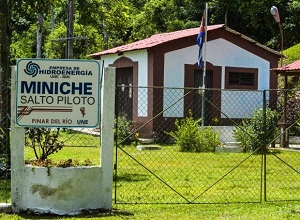 Near the city of Pinar del Río, in Cuba’s westernmost province of the same name, on one side of the highway which runs through the area known as Troncoso, a recent construction breaks the monotony of the desolate landscape, once home to fields of fruit trees.
Near the city of Pinar del Río, in Cuba’s westernmost province of the same name, on one side of the highway which runs through the area known as Troncoso, a recent construction breaks the monotony of the desolate landscape, once home to fields of fruit trees.
This is the Pinar 220 A1 solar park, the first of its kind in the region, equipped with technology which promises to significantly change the province’s electricity supply system.
Despite its three megawatt peak capacity, a little over a year since its inauguration and the Pinar 220 A1 is already showing positive results.
Michel Casal, director of investments at the Cuban electric company in Pinar del Río, states that over the period, the park’s 12,080 solar panels have supplied almost six gigawatts of power to the National Electric System (SEN); highlighting that it would have cost the country over half a million dollars to generate the same amount of energy in one of thermoelectric plants which exist on the island, something that was achieved by the solar park at practically no cost.
PROJECTS UNDERWAY
Such results confirm in practice what had already been identified in studies: exploiting the strong sun rays enjoyed all-year-round in Vueltabajo (as the region is also known), could help to considerably reduce its dependence on fossil fuels.
In regards to Pinar del Río’s first solar park, the highly efficient facility generates a daily average of around 13 MW. “So far the facility has been operating continuously and with a minimum level of maintenance work,” states Michel.
Based on this experience, new parks are continuing to be built across the province, according to the project director.
As such, work is currently underway on the first phase of a new park, located close to Troncoso which, when completed, should provide 2.7 MWp.
Meanwhile a further 28 areas across the entire province, where these types of facilities could be established, have also been identified.
Construction will begin on two of these sites this year, both of which are set to be completed by 2017. The first, located close to Pinar 220 A1 and with a four MWp capacity, will be built by a Chinese company, while the second, based in El Cafetal, San Luis municipality, with a capacity of 2.2 MWp, will be undertaken by the Cuban electric company in Pinar del Río.
The remaining projects are currently awaiting future investments by either Cuban or foreign entities.
OVER 100 YEARS OF HISTORY
The use of renewable energy sources to generate electricity in Cuba’s westernmost province dates back over a century.
According to historians, such efforts began in December 1912 with the opening of the Salto de Pilotos hydroelectric plant, the oldest in the country and still operating, but with more modern equipment.
Next came the San Vicente facility in the municipality of Viñales, and El Salto, in Guane, both constructed in 1920 and which continue to function today.
These represent isolated cases, however, with minimal impact in terms of both kilowatts generated and fuel savings.
However, this reality which has marked the life of the province for over a century, is set to change significantly over the coming years, thanks to the emergence of more efficient technologies, a reduction in investment costs, and the priority which the country currently affords the issue.
Jorge Luis Arzola, director of the Hydropower Basic Enterprise Unit (UEB) in Vueltabajo, notes that in addition to the company’s seven plants there are plans to add another eight before the end of 2020, with an output capacity five times greater than the 415KW generated by existing facilities. Almost all will be located downstream from reservoirs, and designed to supply clean energy directly to the SEN.
MODIFYING THE ENERGY SYSTEM
With the aim of modifying the region’s energy system, the 28 areas selected for the construction of solar parks – spanning a total of 179 hectares – should supply a total of 105.9 MWp to the SEN.
According to Michel, the program set to be implemented gradually over the coming years, will supply a good part of the energy consumed by the province.
“Today the maximum peak is about 154MW, so we’re talking about covering almost 70% of the provinces energy needs with solar panels.”
In economic terms, the beneficial impact of the program is predicted to be huge, considering the amount of fuel that will be saved, which will also have a positive effect on the environment.
“The amount of CO2 that will no longer be emitted is considerable, if we bear in mind that thousands of tons are being saved in the Pinar 220 A1 park alone,” states Michel
A little over a century since the Salto de Pilotos hydroelectric plant was opened generating electricity with fossil fuels is no longer a necessity; thus it seems that the time of renewable energy has finally arrived in the province.
Near the city of Pinar del Río, on one side of the highway which runs through the area known as Troncoso, the construction of the region’s third solar park – for a total of six scheduled to be built there – seems to prove as much, together with the studies and projects conducted over recent years, geared toward generating clean energy through the use of natural, environmentally friendly renewable energy sources.
(Granma)